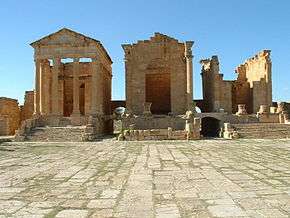Archaeological site of Sbeitla
 Capitoline Hill of Sufetula | |
 Shown within Tunisia | |
| Location | Sbeitla, Tunisia |
|---|---|
| Coordinates | 35°14′25″N 9°7′11″E / 35.24028°N 9.11972°ECoordinates: 35°14′25″N 9°7′11″E / 35.24028°N 9.11972°E |
| Site notes | |
| Excavation dates | 1906-1921[1] |
The archaeological site of Sbeitla is an archaeological site in Sbeitla, in north-central Tunisia. It represents the Roman ruins of Sufetula,[2] and contains the best preserved Roman forum temples in Tunisia. It was excavated and restored between 1906 and 1921.
History
The city was founded, if not already in existence, during the reign of Emperor Vespasian. Sufetula was the theatre of the great confrontation between Byzantines and Arabs in 647,[1] setting the stage for the later Muslim conquest of the diocese of Sufetula and further conquests in southern Europe.
Main sights
Roman remains

Roman bath with fish mosaic
- The Triumphal Arch of the Tetrarchy at the entrance to the city commemorates the four emperors that governed the empire in the year 300, just before the rule of Constantine the Great
- The Public Baths
- The Forum, one of the best preserved in the world
- The Gate of Antoninus, which stands at the entrance to the forum and can be dated between 138 and 161. Its inscriptions make reference to Antonius Pius and his two adopted sons, Lucius Verus and Marcus Aurelius
- The three temples. Instead of constructing only one temple dedicated to the three most important Roman gods (Jupiter, Juno, and Minerva), the inhabitants of the city built separate temples for each one. A similar arrangement is only found at Baelo Claudia in Spain.
- Other important buildings include the theater and the public fountains.
Byzantine remains
The majority of the Byzantine buildings stand on the foundations and incorporate elements of earlier Roman ones. They include:
- The Basilica of Bellator (late 4th or early 5th century), named for a local bishop[3] and including
- The Chapel of Jucundus, which served as a baptistery and was named for an early 5th-century bishop buried there[3]
- The Basilica of Vitalis (5th-6th century), named for its founding presbyter. An basin predating the church and decorated by a fish mosaic was found under the floor of its nave.[3][4]
- The Church of Servus (5th century), named for its presbyter[3]
- The Church of Saints Gervase, Protase, and Tryphon
See also
- Gregory the Patrician, Byzantine exarch and self-proclaimed Emperor of Africa; killed in the Battle of Sufetula by the Muslims in 647
References
- 1 2 SUFETULA (Sbeitla) Tunisia., A. ENNABLI
- ↑ Archaeological site of Sbeitla, Tunisian National Institute of Historic and Artistic Heritage, December 15, 2010
- 1 2 3 4 J. Patout Burns, Robin M. Jensen, Christianity in Roman Africa: The Development of Its Practices and Beliefs, p. 149 ff. Eerdmans 2014, ISBN 9780802869319
- ↑ http://ancientrome.ru/art/artworken/img.htm?id=1959
This article is issued from Wikipedia - version of the 7/22/2016. The text is available under the Creative Commons Attribution/Share Alike but additional terms may apply for the media files.
%2C_Algeria_04966r.jpg)